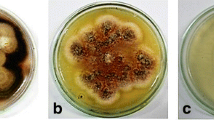Abstract
Calcium (Ca2+) signal transduction pathways play important roles in the regulation of diverse biological processes in eukaryotes ranging from unicellular (e.g., yeasts) to complex multicellular (e.g., humans) organisms. Small-molecule inhibitors of Ca2+-signaling pathways in humans can be of great medical importance, as represented by the immunosuppressants FK506 and cyclosporine A. A high-throughput drug screening assay for inhibitors of Ca2+-signaling has been developed on the basis of the ability of test compounds to restore the severe growth defect of a Ca2+-sensitive zds1 null-mutant strain YNS17 of Saccharomyces cerevisiae in a medium containing a high concentration of calcium ions. A previous screening of Thai medicinal plants using this yeast-based assay indicated that the crude extract of Kaempferia parviflora Wall. Ex. Baker contains a potent inhibitory activity. The aim of this study was to isolate and characterize the pure compound(s) responsible for this inhibitory activity against Ca2+-mediated cell-cycle regulation in yeast. Dichloromethane and methanol extracts of K. parviflora rhizomes were subjected to bioassay-mediated chromatographic fractionation using this yeast [YNS17 (Δzds1) strain]-based assay to screen for and select positive fractions. From the dichloromethane extract, four known flavonoid compounds with significant inhibitory bioactivity were obtained: compounds 1 (5-hydroxy-3,7-dimethoxyflavone), 2 (5-hydroxy-7-methoxyflavone), 3 (5-hydroxy-3,7,4’-trimethoxyflavone) and 4 (5,7-dimethoxyflavone). The inhibitory activity of all four compounds was dose-dependent. Compound 1 exhibited the highest activity and with no observed cytotoxic activity against the yeast. The Ca2+ induced severe growth defect, abnormal budding morphology, and G2 cell-cycle delay of the Δzds1 yeast strain were all alleviated or abrogated by 200 μM compound 1. Therefore, we conclude that 5-hydroxy-3,7-dimethoxyflavone possesses a potent inhibitory activity against the Ca2+-mediated cell-cycle regulation.




Similar content being viewed by others
References
Azuma T, Kayano S, Matsumura Y, Konishi Y, Tanaka Y, Kikuzaki H (2011) Antimutagenic and α-glucosidase inhibitory effects of constituents from Kaempferia parviflora. Food Chem 125:471475
Boonkerd S, Yompakdee C, Miyakawa T, Chavasiri W (2011) Screening of Thai medicinal plants for inhibitor of Ca2+signaling using a yeast cell growth-based assay. Res J Pharm Biol Chem Sci 2:549–557
Chanklan R, Aihara E, Koga S, Takahashi H, Mizunuma M, Miyakawa T (2008) Inhibition of Ca2+−signal-dependent growth regulation by radicicol in budding yeast. Biosci Biotechnol Biochem 72:132–138
Chomchalow N, Bansiddh IJ, MacBaine C (2003) Amazing Thai medicinal plants. Horticultural Research Institute (HRI), Department of Agriculture and Horticultural Science Society of Thailand (HSST), Bangkok
Clapham DE (1995) Calcium signaling. Cell 80:259–268
Jaipetch T, Reutrakul V, Tuntiwachwuttikul P, Santisuk T (1983) Flavonoids in the black rhizomes of Boesenbergia pandurata. Phytochemistry 22(2):625–626
Mager WH, Winderickx J (2005) Yeast as a model for medical and medicinal research. Trends Pharmacol Sci 26:265–273
Mizunuma M, Hirata D, Miyahara K, Tsuchiya E, Miyakawa T (1998) Role of calcineurin and Mpk1 in regulating the onset of mitosis in budding yeast. Nature 392:303–306
Panthong A, Kanjanapothi D, Tuntiwachwuttikul P, Pancharoen O, Reutrakul V (1994) Anti-inflammatory activity of flavonoids. Phytomedicine 1:141–144
Putiyanan S, Chansakaow S, Phrutivorapongkul A, Charoensup W (2004) Standard Pharmacognostic characteristic of Thai herbal medicine, Research Book Faculty of Pharmacy, Chiang Mai University, Chiang Mai ISBN: 974-658-299-2 (CMU Journal)
Sawasdee P, Sabphon C, Sitthiwongwanit D, Kokpol U (2009) Anticholinesterase activity of 7-methoxyflavones isolated from Kaempferia parviflora. Phytother Res 23:1792–1794
Shitamukai A, Mizunuma M, Hirata D, Takahashi H, Miyakawa T (2000) A positive screening for drugs that specifically inhibit the Ca2+-signaling activity on the basis of the growth promoting effect on a yeast mutant with a peculiar phenotype. Biosci Biotechnol Biochem 64:1942–1946
Sudwan P, Saenphet K, Saenphet S, Suwansirikul S (2006) Effect of Kaempferia parviflora Wall. ex. Baker on sexual activity of male rats and its toxicity. Southeast Asian J Trop Med Public Health 37:210–215
Sutthanut K, Sripanidkulchai B, Yenjai C, Jay M (2007) Simultaneous identification and quantitation of 11 flavonoid constituents in Kaempferia parviflora by gas chromatography. J Chromatogr A 1143:227–233
Tewtrakul S, Subhadhirasakul S, Kummee S (2008) Anti-allergic activity of compounds from Kaempferia parviflora. J Ethnopharmacol 116:191–193
Wangkangwan W, Boonkerd S, Chavasiri W, Sukapirom K, Pattanapanyasat K, Kongkathip N, Miyakawa T, Yompakdee C (2009) Pinostrobin from Boesenbergia pandurata is an inhibitor of Ca2+-signal-mediated cell-cycle regulation in the yeast Saccharomyces cerevisiae. Biosci Biotechnol Biochem 73:1679–1682
Wattanapitayakul SK, Suwatronnakorn M, Chularojmontri L, Herunsalee A, Niumsakul S, Charuchongkolwongse S, Chansuvanich N (2007) Kaempferia parviflora ethanolic extract promoted nitric oxide production in human umbilical vein endothelial cells. J Ethnopharmacol 110:559–562
Yenjai C, Prasanphen K, Daodee S, Wongpanich V, Kittakoop P (2004) Bioactive flavonoids from Kaempferia parviflora. Fitoterapia 75:89–92
Acknowledgments
This work was supported by the National Research University Project (FW645A) and Chulalongkorn University Century Academic Development Project to TM. The authors would like to thank Dr. Tanapat Palaga for use of the flow cytometer facility, which was purchased under the Thai Government Stimulus Package 2 (TKK2555) under the Project for Establishment of a Comprehensive Center for Innovative Food, Health Products and Agriculture, and Ms. Naunpun Sangphech for technical assistance on flow cytometric analysis.
Author information
Authors and Affiliations
Corresponding author
Rights and permissions
About this article
Cite this article
Boonkerd, S., Yompakdee, C., Miyakawa, T. et al. A flavonoid, 5-hydroxy-3,7-dimethoxyflavone, from Kaempferia parviflora Wall. Ex. Baker as an inhibitor of Ca2+ signal-mediated cell-cycle regulation in yeast. Ann Microbiol 64, 1049–1054 (2014). https://doi.org/10.1007/s13213-013-0742-6
Received:
Accepted:
Published:
Issue Date:
DOI: https://doi.org/10.1007/s13213-013-0742-6




